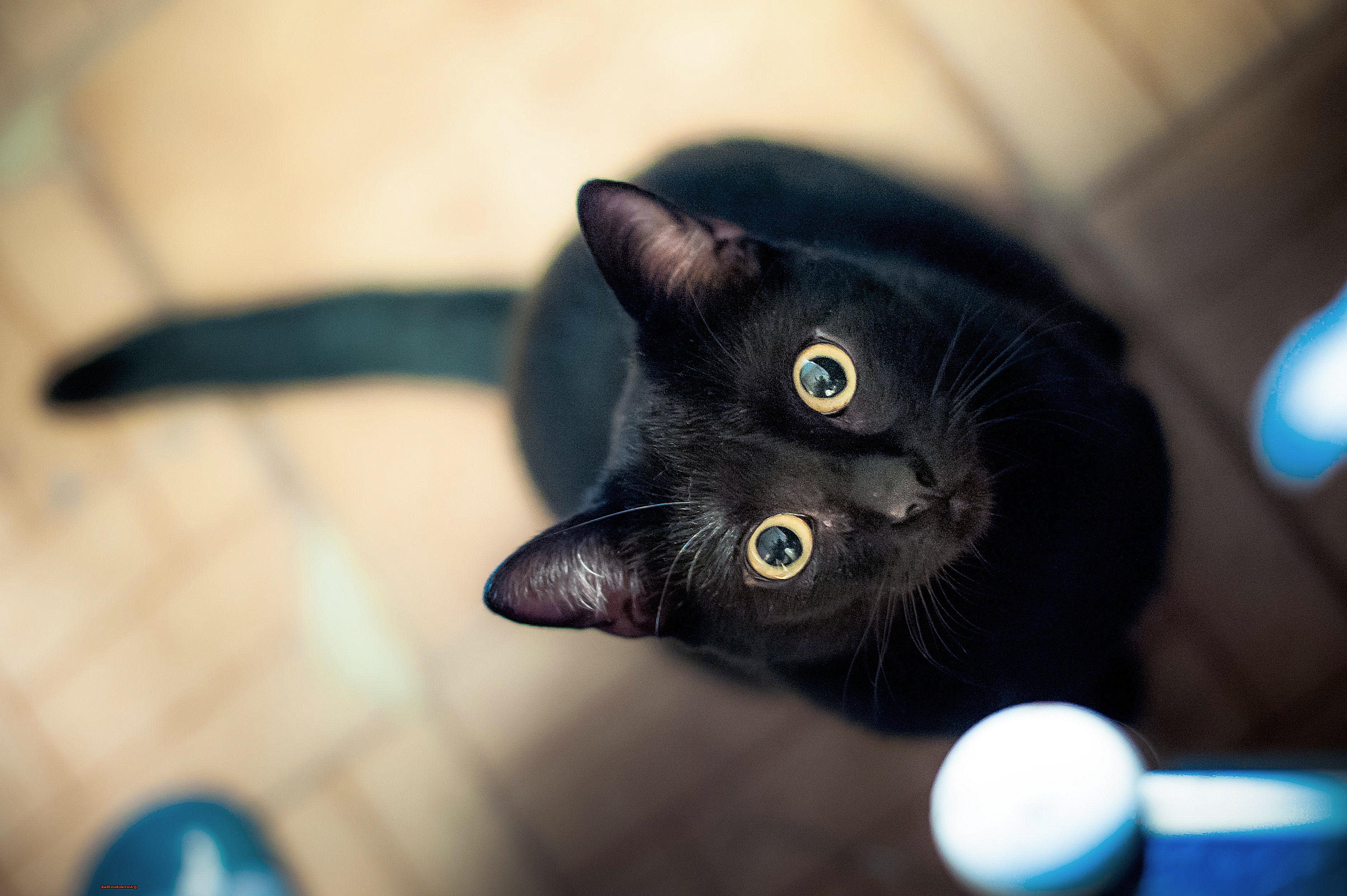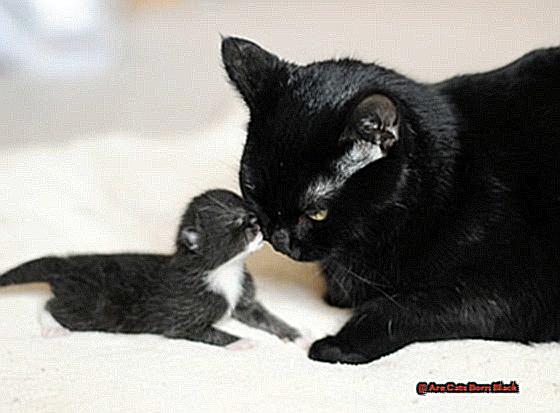Curious minds have long pondered the origins of black-coated cats.
Is it a hereditary trait or a mere coincidence? As a devoted feline admirer and avid investigator, I couldn’t resist diving into this enigma.
And let me tell you, the truth behind why cats are born black is far from mundane. So grab your purring companion and join me on this journey as we unravel the secrets of these dark-furred creatures.
By the end of this post, you’ll have a newfound admiration for our mysterious feline friends.
Are Cats Born Black?
Contents
As a cat owner, you may have noticed that your black kitten’s fur has changed to a different color as they matured. This may come as a surprise, but it is actually a common occurrence in cats. So, why do some cats change their coat color from black to something else? Let’s dive into the science behind it.
Genetics Play a Big Role
The dominant gene for coat color in cats is black, which means that all cats are born with the potential to have a black coat. However, this doesn’t mean that all cats end up with a black coat. Other genes, such as recessive genes for colors like white or orange, can affect the coat color of a cat.
This means that while some cats may be born with a black coat, others may be born with a different color and change to black as they mature. These changes happen due to hormonal changes and the activation of certain genes in the first few weeks of life.
Different Breeds, Different Patterns
In some breeds, such as Siamese and Burmese, kittens are born with a lighter coat color and gradually darken as they grow older. This is due to the presence of temperature-sensitive enzymes that cause a darker pigment in cooler areas of the body.
On the other hand, breeds like Bombay and Maine Coon have kittens that are born with a solid black coat that remains unchanged throughout their lives.
Timing is Everything
The timing of when a cat’s fur changes color can vary depending on factors like genetics, nutrition, and overall health. Some cats may have a mix of colors in their fur, such as tabby stripes or white spots, but still have an overall black appearance.
It is also possible for a cat to be born with a black coat and have it fade or change to a different color as they age. This could be due to a genetic mutation or illness that affects the production of melanin.
Keep an Eye Out for Changes

While most cats are born with their permanent fur color, there are some instances where they may experience a change in color later on in life.
In rare cases, cats may also develop vitiligo, a condition that causes patches of fur to lose pigment and turn white. This can happen at any age, including from birth.
Understanding the role of melanin in determining fur color
As cat owners, we all know that our furry companions come in a variety of colors and patterns. But have you ever wondered how their fur color changes over time? The answer lies in a pigment called melanin.
What is Melanin?
Melanin is a pigment produced by special cells called melanocytes. It gives color to the skin, hair, and fur of animals. In cats, there are two types of melanin: eumelanin, which produces black and brown colors, and pheomelanin, which produces orange and red colors.
Melanocytes: The Key Players in Fur Color Changes
When kittens are born, they have a thin layer of fur that is usually light grey or beige. This is because their melanocytes are not fully developed yet. As they grow and mature, their melanocytes start producing more melanin, resulting in a change in their fur color.
For cats that are born black, their melanocytes produce a higher amount of eumelanin, resulting in a darker coat. On the other hand, cats with orange or red fur have higher levels of pheomelanin.
Genetics: The Other Piece of the Puzzle
While melanin plays a significant role in determining fur color, genetics also play a crucial role. Just like humans, cats inherit certain genes from their parents that determine their fur color. This is why some cats may be born with different fur colors despite being from the same litter.
Breed also plays a part in fur color genetics. For example, breeds like the Bombay and Maine Coon are known for being born with black fur due to their genetic makeup.
The Influence of Diet and Environment
Apart from genetics, diet and environment can also affect the production of melanin in cats. A balanced diet rich in nutrients can help maintain healthy levels of melanin production, resulting in vibrant fur colors. Changes in environment, such as exposure to sunlight and temperature, can also impact melanin production, leading to changes in fur color over time.
Vitiligo: A Rare Phenomenon
In rare cases, cats may develop vitiligo, a condition where there is a loss of melanocytes in certain areas of their body, resulting in white patches on their fur. This can happen at any stage of their life, including when they are born.
The different shades of black in cats
Black cats have always been associated with mystery, magic, and even misfortune. But did you know that not all black cats are created equal? That’s right; there are various shades of black seen in cats, and each one has its unique story to tell.
As a cat expert, I have delved into the world of feline genetics and come across some fascinating insights on how these shades come to be.
So, let’s take a closer look at the different shades of black in cats and what influences them.
Genetics: The Key Player
Just like humans, cats inherit their physical traits from their parents through genetics. The color black in cats is determined by the presence or absence of melanin – the pigment responsible for dark colors in animals. The more melanin a cat has, the darker their fur will be.
This means that a cat with high levels of melanin will have a jet black coat, while a cat with lower levels will have a lighter shade of black.
Breeding: Manipulating Genes for Unique Colors
Did you know that breeders can manipulate genes to create different shades and patterns in cats’ fur? It’s true. Through selective breeding, breeders can produce cats with specific coat colors and patterns, including shades of black. This explains why some breeds, such as Bombay and Cornish Rex cats, are known for their deep jet-black coats.
Environmental Factors: The Sun’s Impact on Fur Color
Believe it or not, the environment can also play a role in the shade of black seen in cats. Cats living in warmer climates tend to have a darker shade of black due to increased levels of melanin production. This is because the extra melanin acts as a natural sunscreen, protecting their skin from the sun’s UV rays.
Age: Changing Shades as Cats Grow Older
Just like humans, cats’ fur can also change with age. Some cats may start off with a lighter shade of black and then darken as they grow older due to changes in their genes or health conditions. This is especially true for older cats, whose fur may start to gray, giving them a distinguished salt-and-pepper look.
How a cat’s fur color can change with age
From the moment your black kitten snuggled into your arms, you were convinced that they would always have that sleek, shiny coat. But as they grew older, you noticed subtle changes in their fur color. Suddenly, you were questioning if they were even the same cat.
Many cat owners are surprised to see their feline’s fur color change with age. In this post, we’ll dive into the fascinating world of a cat’s fur color and how it can change over time.
The Basics: How Fur Color is Determined
Just like humans, a cat’s fur color is determined by genetics. The pigment-producing cells in their skin, called melanocytes, produce melanin, which gives fur its color. If a kitten has a high concentration of melanocytes, they are more likely to have a darker fur color, such as black. On the other hand, if they have a lower concentration, their fur may be lighter or even white.
Factors That Contribute to Fur Color Change
Genetics
Genes play a significant role in a cat’s fur color. Some genes control how much melanin is produced and where it is distributed in the coat. This is why certain breeds, like Siamese and Himalayan cats, are known for their “points” – darker areas on their face, ears, paws, and tail. These cats are born with lighter-colored fur and gradually develop their darker points as they age.
Hormonal Changes
As cats reach sexual maturity, their hormones can affect the production of melanin, causing changes in their coat color. Male cats may appear darker than females due to higher levels of testosterone.
Aging
Just like humans, cats’ hair can start to turn gray as they get older. This is due to a decrease in melanocyte activity and production, causing the fur to lose its pigment and appear lighter or white.
Environmental Factors
While genetics and hormones play a significant role, environmental factors such as sun exposure and diet can also impact a cat’s fur color. Sunlight can cause bleaching of the fur, while certain nutrients in food can affect the production of melanin.
Breeds that are not born with black fur
These breeds are known for their distinct pointed pattern, where the face, ears, paws, and tail are a darker color than the rest of the body. This coloration is determined by genetics and is present at birth, unlike black fur which can change over time.
Siamese Cats
Siamese cats are famous for their striking dark points, which can range from seal point (dark brown) to blue point (pale gray). These points are caused by a gene that inhibits the production of pigment in the fur, resulting in a lighter color. This gene also gives them those mesmerizing blue eyes.
Birman Cats
Birman cats also have a pointed pattern but with white points instead of dark ones. This is due to a gene that causes partial albinism in these cats. Their distinctive white paws are known as “gloves” and their white chin is called a “bib.” Like Siamese cats, Birman cats are born with their pointed pattern and white markings.
Maine Coon Cats
On the other hand, Maine Coon cats are not born with black fur but can have black markings on their bodies. This is because they have a wide range of fur colors and patterns, but black is not one of them. So if you’re a fan of black cats, the Maine Coon might not be your first choice.
Scottish Fold Cats
The Scottish Fold is another breed that doesn’t come in black. These cats have a unique folded ear mutation that gives them their signature look. While they come in many different colors and patterns, black is not one of them. This is due to the same gene that causes partial albinism in Birman cats.
Factors that can affect a cat’s fur color
Some cats have sleek, all-black fur, while others have a striking pointed pattern. But have you ever wondered what exactly determines a cat’s fur color? Is it genetics, breed, or something else entirely? Let’s dive into the various factors that can affect a cat’s fur color and unravel the mysteries behind it.
- Genetics: Just like humans, cats inherit genes from their parents that determine their physical characteristics, including their fur color. The genes responsible for fur color are called melanocortin 1 receptor (MC1R) genes, and they come in different variations. These variations can result in different coat colors, including black.
- Breed: Different cat breeds are more likely to have certain coat colors than others. For example, the Bombay cat is known for its sleek, all-black coat due to its selective breeding for this specific trait. On the other hand, breeds like the Siamese and Himalayan are known for their pointed coats, meaning they have a lighter body with darker points on their face, ears, and tail.
- Age: While most cats are born with their permanent fur color, some breeds have a gene that causes them to have a lighter coat at birth. As they age, their coat gradually darkens to its permanent color. This phenomenon is known as “temperature-sensitive albinism.” So don’t be surprised if your Siamese kitten’s coat lightens up as they grow older.
- Environment: Exposure to sunlight can also play a role in a cat’s fur color. Outdoor cats who spend a lot of time in the sun may have lighter or bleached out fur, while indoor cats may have richer or darker coats due to lack of exposure to sunlight.
- Nutrition: A cat’s diet can also impact their fur color. A lack of essential nutrients, such as protein and fatty acids, can result in dull or discolored fur. These nutrients are vital for healthy hair growth and coat color, so make sure your feline friend is getting a well-balanced diet.
Rare instances of a cat’s fur color changing later in life
Genetics:
Just like humans, cats inherit their fur color from their parents. This means that most cats’ fur color remains the same throughout their life. However, genetic mutations can occur, resulting in a change in fur color. This can happen gradually or suddenly, creating a striking and unexpected appearance.
Fever Coat:
Another factor that can cause a cat’s fur color to change is “fever coat.” This happens when a pregnant cat becomes ill or experiences high levels of stress during pregnancy. The kittens’ fur color may be temporarily affected, resulting in lighter-colored fur that may darken as they grow older.
External Factors:
Exposure to sunlight and certain medications can also contribute to a change in a cat’s fur color. Sunlight can cause the melanin in a cat’s fur to oxidize, resulting in a lighter or reddish tint. Certain medications, such as chemotherapy drugs, can also affect a cat’s fur color temporarily.
Breeds Prone to Color Changes:
Some breeds of cats are more prone to changes in their fur color than others. For example, Siamese and Himalayan cats have temperature-sensitive pigment production genes that cause their fur to darken with age. Persian cats may also experience changes in their fur color due to temperature and hormonal influences.
Health Issues:
In rare cases, a cat’s fur color change may be a sign of an underlying health issue. For instance, hypothyroidism can cause black cats’ fur to turn brownish-red or even gray due to changes in hormone levels. If you notice an unexpected change in your cat’s fur color, it is best to consult with a veterinarian to rule out any potential health concerns.
Conclusion
In conclusion, the mystery of black-coated cats has been a source of fascination for cat lovers and researchers alike. As a devoted feline admirer and avid investigator, I have delved into this enigma and uncovered some intriguing insights.
Genetics play a significant role in determining a cat’s fur color, but there are also other factors at play. Hormones, age, and environment can all influence the color of a cat’s coat. While breeds like Siamese and Bombay are known for their distinct coat colors, others like Maine Coon and Scottish Fold do not come in black at all.
The science behind melanin production sheds light on how different levels of this pigment can result in various shades of black in cats. And let’s not forget about the unique patterns seen in felines, such as pointed patterns and bicolor coats.
But what makes it even more fascinating is that some cats can experience changes in their fur color due to genetic mutations or health issues. So as responsible owners, it is essential to monitor our furry friends’ coats for any unexpected changes and seek veterinary advice if necessary.
So next time you cuddle up with your purring companion, remember that there is more to their black coat than meets the eye. These mysterious creatures continue to captivate us with their ever-changing colors and patterns.






